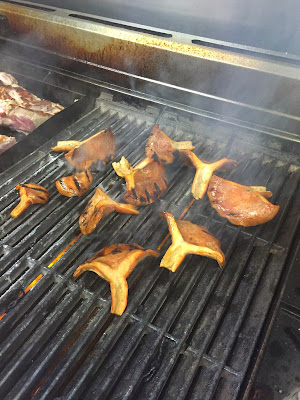Mushroom hunting, Melbourne
I’d been talking of going mushrooming with my sous chef, Jayne, for a while as we’d both started seeing urban ‘shrooms start to pop up in parks and on inner city scrub – the season had begun – but we’d never had corresponding days off, so it hadn’t materialised. Last Friday we did, however, and, along with Jayne’s girlfriend, Helen, we headed an hour and a half out of Melbourne to a National Park, of which I forget the name.
 |
| Saffron Milkcaps |
Saffron Milkcaps are nearly always found under pine (they’re know as Pine Mushrooms here) due to the mycelial connections they make with their host plant – beneficial for both mushroom and plant, the mycelial threads that join onto the root system form a two way nutrient exchange platform – the plant supplies the fungi with carbohydrates and in return the fungi aids the trees water absorption and provide nutrients like phosphorous and nitrogen via their mycelia. Whereas Saffron Milkcaps nearly always form these connections with pines, False Saffron Milkcaps (Lactarius deterrimus), a less well regarded, but still quite delicious edible, tend to prefer spruce.
As we were driving our eyes were peeled, we passed numerous firs and other conifers but it wasn’t until we got to with ten minutes of the national park that we hit the jackpot; rows of plantation Scots Pine (Pinus sylvestris) right by the roadside, and just underneath them on a grassy verge, a tonne of mushrooms.
 |
| Fly Agarics |
We hopped out the car and the yelps and yips began; there were hundreds of mushrooms, of about 4 or 5 different species - some type of Russula, which exact species I do not know, Fly Agarics (Amanita muscaria), the classic fairytale mushroom, with its red cap and white spots. A very interesting mushroom actually; it can be edible, hallucinogenic or poisonous depending on how you prepare it, though that’s another story. Although we weren’t after Fly Agarics I was excited to see them as they’re usually a good indicator for Ceps (Boletus edulis) or other choice Boletus; they have similar growing preferences, but none were to be found, just a load of big, spongy fungi in the Suilleus genus, I’m not sure the exact species – they looked similar to Bovine Boletes (Suilleus bovinius), not the best for the pot, certainly not when growing amongst Saffron Milkcaps.
 |
| Helen + Saffron Milkcaps |
 |
| Fly Agaric (Amanita muscaria) |
I had work at 6 in the evening, so headed straight there armed with my bag of Saffron Milkcaps. Instead of taking my half an hour break, I chose to instead play with my ‘shrooms. After a quick clean with a dry towel, I liberally salted them and basted them with a sauce consisting of butter, confit garlic, brown sugar, and Worcestershire sauce. They went straight on the grill and were cooked over a high heat until charred, soft and sweating. Another liberal sprinkling of salt was needed in order to bring out the mushroom-y flavour. The result? Quite delicious, if I may say so myself. They had a real meaty flavour and a pleasantly soft, if not slightly slimy, texture, enhanced by the areas that were charred and crispy. I feasted on ‘shrooms until my half an hour was up and then got back to work. A good day out.








0 comments:
Post a Comment